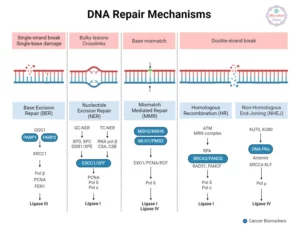Radiation therapy is a cornerstone in the treatment of cancer, targeting and killing cancerous cells through high-energy radiation. However, the process is complex, and not all cells in the body respond the same way to radiation. Some cells are able to withstand its effects better than others, and understanding how they do so is critical to improving cancer treatments. In this article, we will explore how cells are wired to survive radiation therapy, focusing on the biological mechanisms involved in radiation resistance and how researchers are studying these processes to make cancer therapies more effective.

What Happens When Cells Are Exposed to Radiation?
Radiation therapy works by damaging the DNA within cells. When the DNA is damaged, it can lead to cell death, or in some cases, mutations that disrupt the cell’s normal function. There are two main types of radiation-induced DNA damage:
- Direct DNA damage: The radiation directly affects the DNA strands, causing breaks or mutations.
- Indirect DNA damage: Radiation ionizes water molecules inside the cell, creating free radicals that then damage the DNA.
Despite the effectiveness of radiation therapy, not all cells die immediately, and some manage to survive and even repair the damage.
How Do Cells Repair Radiation Damage?
 Cells have evolved sophisticated repair mechanisms that help them cope with radiation-induced DNA damage. Here are the main processes that play a role in cellular resistance to radiation:
Cells have evolved sophisticated repair mechanisms that help them cope with radiation-induced DNA damage. Here are the main processes that play a role in cellular resistance to radiation:
1. DNA Repair Mechanisms
-
Double-Strand Break Repair: Radiation often causes double-strand breaks (DSBs) in DNA. These breaks are repaired through two key mechanisms:
- Homologous Recombination (HR): This is an accurate repair method that uses a sister chromatid as a template to fix the break.
- Non-Homologous End Joining (NHEJ): This method directly joins the broken ends of DNA without a template, though it is more error-prone.
-
Base Excision Repair (BER): This repair pathway targets smaller DNA damage, such as oxidized bases created by radiation-induced free radicals. The enzyme DNA glycosylases recognize and remove damaged bases before the DNA is resynthesized.
-
Nucleotide Excision Repair (NER): This repair pathway removes large sections of damaged DNA caused by radiation and restores the DNA using the opposite strand as a template.
Image: A diagram showing the process of DNA double-strand break repair.
2. Cell Cycle Checkpoints
After radiation damage, cells often go through a process of “checking” their DNA to determine if it is safe to divide. These checkpoints ensure that the cell does not divide with damaged DNA, which could lead to cancer or cell death.
- G1 Checkpoint: Before the cell enters the S-phase (DNA synthesis), the cell checks for DNA damage. If damage is detected, the cell will pause, giving it time to repair the damage.
- G2/M Checkpoint: This checkpoint ensures that DNA replication has been completed without errors before cell division occurs. If DNA damage is detected, the cell may enter a state of dormancy or undergo apoptosis (programmed cell death).
Image: A flowchart of cell cycle checkpoints.
3. Apoptosis Resistance
While many cells undergo apoptosis in response to severe radiation-induced DNA damage, some cancer cells have evolved mechanisms to resist this process. One such mechanism involves mutations in key apoptotic proteins, such as p53. The p53 protein is known as the “guardian of the genome” because it can trigger apoptosis when DNA damage is irreparable.
In many cancers, however, p53 is mutated or its activity is suppressed, allowing the cells to survive despite severe DNA damage. This resistance to apoptosis allows these cells to continue proliferating, even after radiation therapy.
Image: Diagram illustrating the role of p53 in apoptosis.
4. Tumor Microenvironment and Oxygen Availability
The tumor microenvironment also plays a significant role in the survival of cancer cells during radiation therapy. Oxygen is essential for the effectiveness of radiation because it enhances the DNA-damaging effects of radiation. Tumors, however, often have regions of low oxygen (hypoxia), where cells are more resistant to radiation-induced damage.
In hypoxic conditions, cancer cells activate hypoxia-inducible factors (HIFs), which help the cells survive by promoting processes like angiogenesis (formation of new blood vessels) and metabolism changes. These factors allow the tumor to grow and resist radiation treatment.
Image: Representation of tumor hypoxia and its effect on radiation resistance.
How Researchers Are Leveraging This Knowledge
Understanding how cells repair DNA and resist radiation has led to the development of new strategies to improve radiation therapy. Some of the most promising approaches include:
-
Targeting DNA Repair Pathways: Inhibiting the repair of DNA damage in cancer cells can sensitize them to radiation. Drugs that target PARP inhibitors (which block repair pathways) are already being used in combination with radiation to enhance treatment outcomes.
-
Overcoming Apoptosis Resistance: Researchers are investigating ways to reactivate apoptotic pathways in cancer cells, especially those with dysfunctional p53 proteins. By restoring apoptosis, it may be possible to make cancer cells more susceptible to radiation.
-
Improving Tumor Oxygenation: Strategies to overcome tumor hypoxia, such as the use of oxygen mimetics or drugs that improve blood flow, are being tested to make tumors more responsive to radiation therapy.
Conclusion
Cells are equipped with an arsenal of repair mechanisms that help them survive radiation therapy, making cancer treatment more challenging. From DNA repair to apoptosis resistance, and the tumor microenvironment, these factors contribute to a cell’s ability to endure radiation. Understanding these complex processes not only improves our understanding of cancer biology but also opens up new avenues for enhancing the effectiveness of radiation therapy and overcoming resistance.
Sources:
- Radiation Biology in Cancer Therapy – Cancer Research Institute. (https://www.cancerresearch.org)
- Mechanisms of DNA Damage and Repair – National Institute of Environmental Health Sciences. (https://www.niehs.nih.gov)
- Tumor Microenvironment and Radiation Resistance – Nature Reviews Cancer. (https://www.nature.com)
















